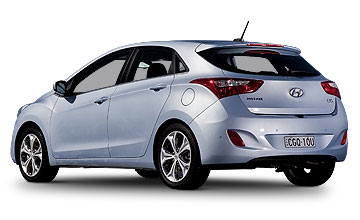BY MIKE COSTELLO AND TIM NICHOLSON | 30th May 2012

The company has clearly centred its audacious play at class benchmarks like the Mazda3, Ford Focus and Volkswagen Golf with a list of standard features that leaves them – and many cars in higher segments – in the shade.
The mid-range Elite has features such as a colourful seven-inch touchscreen with a clear and legible satellite-navigation system, including SUNA traffic updates, and a reversing camera mounted behind a rotating rear badge just like the Golf.
The Premium variant steps further upmarket with good quality leather seats, classy 17-inch wheels, electronic park brake from the i40 wagon, and a panoramic sunroof.
The cabin is mostly well laid-out, with major instruments feeling tactile and within easy reach, and plenty of storage options scattered around.
Essential controls are simple to use, and the Bluetooth system pairs up devices in a matter of seconds – something not all rivals can claim.
Legroom both front and rear is acceptable and the rear seats have better bolstering than most, but headroom and shoulder room in the back row is tight for larger occupants, while the full-length sunroof on the Premium variant further cuts space.
We also didn’t like the cheap and hard plastic adorning the back of the Elite’s seats, which are a trial on the knees, or the glossy black plastic inserts around the dash that are unlikely to age with grace.
Boot space is likewise about on par with hatchback rivals, despite a high loading lip, and can expand three-fold courtesy of folding rear seats.
But, while the cabin offers plenty of glitter, the driving experience on regional Victorian roads fell a touch short of gold.
We drove an Elite model fitted with the 1.8-litre petrol engine matched to a six-speed manual, followed by a Premium variant with a 1.6-litre turbo diesel unit and six-speed auto. The entry-level Active variant was unavailable for testing.
The petrol engine feels responsive enough around town and has acceptable poke off the line, but runs out of puff at higher speeds due to lack of mid-range torque. Overtaking or hill-climbing at high speeds requires plenty of revs and regular down-shifting.
As you would expect, the diesel lacks the immediacy of the naturally aspirated petrol, but makes up for this with a far stronger mid-range and decent levels of refinement at most points of the rev band.
The six-speed manual offers light shifts, although the springy clutch requires some acclimatisation. The optional six-speed automatic will be the volume-seller, and our experience with it in the diesel indicates it may be the pick with its fast and fuss-free shifts, complemented by a manual mode.
However, official fuel figures show that both engines use significantly more fuel when matched to the automatic, which is unusual for a modern self-shifter.
We averaged 7.0 litres per 100 kilometres for the petrol manual and 6.3L/100km for the diesel automatic, both coming close to factory claims in spite of our spirited driving style.
Hyundai made a fanfare about its all-new ‘Flex Steer’ system, standard on all variants, which modulates the weight of the steering system via a button on the steering wheel.
This system is a nice touch, and unheard of in a $21k car, with a feather-light ‘Comfort’ setting for parking and a heavier ‘Sport’ setting for more dynamic environs.
The steering itself is sharp, direct and responsive from centre, but again lacks the organic feedback of a Golf or Mazda3. Still, the car is much more fun to throw around on challenging roads than it was before, with less bodyroll and an unobtrusive stability control system.
Hyundai Australia has struck a nice balance with the suspension, which is once again tuned specifically for local conditions and features unique Sachs dampers.
The Elite is more supple and quiet over corrugations than the Premium courtesy of its smaller 16-inch wheels, with the flagship variant struggling to stay composed over a particularly nasty set of potholes.
In the end, though, while middle-of-the-road dynamics may dissuade some buyers, many more are likely to be tempted by the extremely impressive list of features and eye-catching design inside and out, not to mention the five-year/unlimited-kilometre warranty.
The small-car segment is not jut Australia’s most popular, but is also arguably the most competitive, and Hyundai has done enough with the new i30 to show that it deserves to remain at or near the very top.